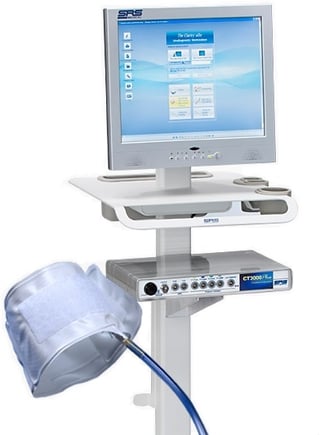 Diagnosing problems with the lower urinary tract requires a range of urodynamic tests to be performed, some of which require catheterization.
Diagnosing problems with the lower urinary tract requires a range of urodynamic tests to be performed, some of which require catheterization.
This procedure can be uncomfortable and embarrassing for the patient, and also result in complications. Now, there is a relatively new, less invasive way to collect data in men that are experiencing lower urinary tract symptoms that are common in patients experiencing disorders such as Benign Prostatic Hyperplasia (BPH).
The principles of the UroCuff, as well as reasons that urologists should offer the UroCuff test, will be discussed.
What is a UroCuff?
The UroCuff is a piece of urodynamic equipment that can be utilized to non-invasively measure urine flow rate and bladder pressure, as well as aid in the diagnosis of voiding disorders.
A small, pneumatic cuff is fitted around a patient’s penis before the bladder is voided. Then, the patient urinates into a portable commode fitted with a flow meter. While the patient is urinating, the cuff is automatically inflated until the patient’s stream of urine is interrupted.
This inflation and interruption cycle is repeated until voiding is complete. The pressure applied to the cuff that was required to interrupt urine flow is equivalent to bladder pressure. Optional surface EMG electrodes can be applied to the patient’s perineum or abdomen to monitor sphincter activity or abdominal straining, respectively.
At the conclusion of the test, a UroCuff report is printed which provides pressure-flow data on a modified nomogram.
When is UroCuff Testing Appropriate?
UroCuff testing can be performed on men who are experiencing lower urinary tract symptoms such as:
- Uncontrollable urge to urinate
- Weak stream
- Painful urination
- Leakage
- Overflow incontinence
- Frequent nighttime urination
- Incomplete bladder emptying
Why Should Urologists Offer UroCuff?
The advantages of UroCuff testing are numerous. Urologists should consider offering UroCuff testing for the following reasons:
Non-Invasive
The traditional manner of diagnosing disorders of the lower urinary tract in men is catheterization, which can be embarrassing, uncomfortable, and result in side effects such as injury or infection. Additionally, catheterization may not be appropriate in all patients, particularly those with existing urethral injury. The UroCuff, on the other hand, is completely non-invasive and provides the same data as traditional pressure flow studies.
More Patient Compliance
Patients are more likely to schedule UroCuff testing because it is a painless procedure that is less embarrassing than traditional urodynamic testing.
Repeatable
The UroCuff test can be repeated once every 6 months, giving urologists the ability to better monitor their patient’s symptoms and treatment plan. Patients are less likely to drop out of their treatment plan when progress is easily (and painlessly) monitored.
Lower Cost
UroCuff testing is lower-cost than traditional urodynamic assessment, as it requires less training and is less time consuming. In the amount of time that a traditional uroflow test can be performed, the same amount of data that would be collected during a pressure flow study is acquired.
Accurate
Independent studies have proven the accuracy of UroCuff testing in comparison to traditional urodynamic assessment. In one study1, the validity, reliability, and usefulness of the penile cuff were measured in men suffering from lower urinary tract symptoms.
For clinical evaluation, 151 men underwent traditional pressure flow studies in conjunction with UroCuff testing. The penile cuff was able to be performed in more than 90% of men with lower urinary tract symptoms, with accuracy measurements that were similar to pressure flow study.
Diagnoses Bladder Outlet Obstruction
UroCuff technology has the ability to differentiate disorders such as bladder outlet obstruction in a fully noninvasive manner. At present, 15 – 30%2 of men who are diagnosed with bladder outlet obstruction do not benefit from surgical intervention; however, careful selection of surgical candidates can be difficult.
Currently, invasive pressure flow studies are the gold standard for diagnosing this disorder, but invasive assessment is not appropriate for all individuals. A definitive diagnosis of bladder outlet obstruction before surgery, however, provides the best surgical outcomes. Nineteen men underwent traditional pressure flow studies and UroCuff assessment for bladder outlet obstruction.
In 92% of patients, the UroCuff was able to positively predict bladder outlet obstruction, with sensitivity of 75%. Not surprisingly, 100% of patients preferred this non-invasive test.
Ultimately, the UroCuff utilizes well-established technology to provide accurate pressure readings for accurate diagnosis of lower urinary tract symptoms in men. Benefits include lower cost, better patient compliance, accuracy, and the ability to provide the same data as more invasive tests.
If you would like more information on providing UroCuff in your practice, click on the button below.
References
- Harding C, Robson W, Drinnan M, et al. The penile cuff test: A clinically useful non-invasive urodynamic investigation to diagnose men with lower urinary tract symptoms. Indian Journal of Urology : IJU : Journal of the Urological Society of India. 2009;25(1):116-121. doi:10.4103/0970-1591.45549. Link
- Matulewicz RS, Hairston JC. (2015). The UroCuff test: a non-invasive alternative to pressure flow studies in adult males with lower urinary tract symptoms secondary to bladder outlet obstruction. Can J Urol. 2015 Aug;22(4):7896-901. Link


